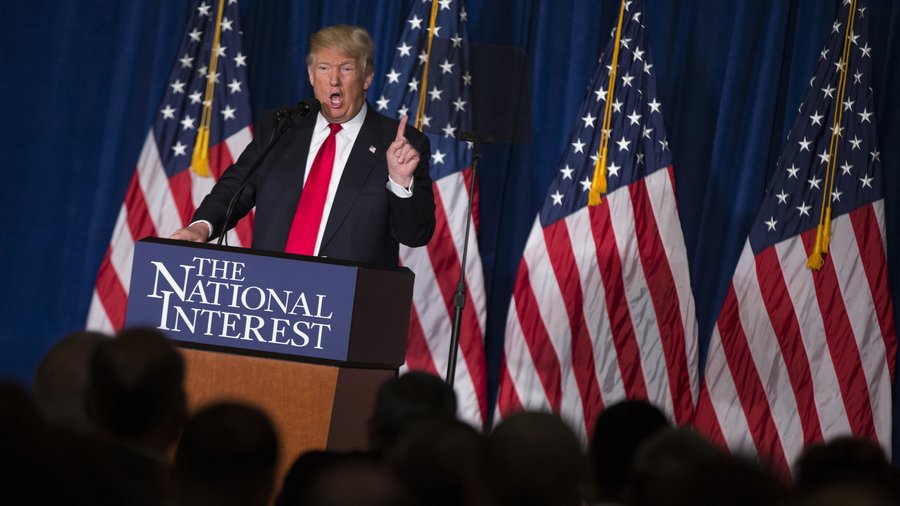
Donald Trump’s campaign started the month with a paltry $1.3 million in cash — a mere fraction of Hillary Clinton’s $42.5 million war chest — putting the GOP front-runner at a sharp disadvantage heading into the general election against Clinton’s money machine.
On the same day that Trump fired his campaign manager, Corey Lewandowski, amid a steady stream of reports of campaign infighting and disorganization, the latest batch of Federal Election Commission filings show that the real estate mogul has a long way to go to establish a financial operation that can compete at the national level.
Story Continued Below
And it’s not just money — the filings revealed a campaign staff of less than 70, a number dwarfed by Clinton’s nearly 700 paid employees, and few of the campaign’s expenses suggested work had begun to build out a more robust operation. All together, it’s the most lopsided fundraising start to a presidential election in the modern campaign finance era.
The filings detail campaign finances covering the month of May, during which Trump locked up the GOP nomination after the May 3 Indiana primary. Republicans had hoped that Trump’s clearing of the field would prompt their donors to rally behind their presumptive nominee and allow him to close the gap with Clinton’s campaign, which was still struggling to finish off primary rival Bernie Sanders.
Instead, the campaign showed no clear path for improving its financial picture. Trump raised just $3.1 million from donors (including almost $2 million in amounts less than $200) and lent his campaign $2.2 million, though he said he won’t continue self-funding through the general election. Trump has now loaned his campaign a total of $45.7 million, almost exactly the same amount that Mitt Romney loaned his 2008 campaign for the GOP presidential nomination.
Unlike Romney, who mostly downplayed his wealth, Trump’s boasts about his wealth and his willingness to self-finance his campaign were a central part of his message during the primary. Trump castigated his primary opponents for being beholden to big donors and called out the donors as puppet masters.
So when Trump decided that he would seek to raise outside money for his own election, the reversal was awkward, not least because he had failed to assemble a finance operation for his skeletal campaign.
On the bright side, Trump’s campaign trimmed spending from $9.4 million in April to $6.7 million in May. But with so little money in the bank, frugality alone won’t make the operation more competitive. Even the defunct campaigns of Ted Cruz and Ben Carson had more cash on hand than Trump’s.
In fact, several House members running for reelection have more cash on hand than Trump’s campaign. Peter King (R-N.Y.) had $3 million, Joe Kennedy (D-Mass.) reported $2.2 million, Sean Patrick Maloney (D-N.Y.) and Lee Zeldin (R-N.Y.) each reported about $1.8 million, and Mike Coffman (R-Colo.) had $1.4 million.
Comparing cash figures was always a little spurious in the primaries, with Trump poised to pump more money into his own campaign (despite conflicting accounts of his actual wealth and liquidity). But he has made clear he won’t bankroll his bid through November, and he’s still a long way from the $300 million his backers say they hope to raise — already a retreat from Trump’s original $1 billion goal.
Meanwhile, the Clinton campaign and its allied super PAC have already amassed more than $300 million.
The May FEC report showed just 69 people on payroll, to Clinton’s 685. And the Trump campaign’s spending offered no signs that it is building a national campaign infrastructure. The biggest expenditures included $350,000 for the use of Trump’s private jet; $493,000 to rent Trump facilities such as Mar-A-Lago, the Trump winery and two of his golf clubs; and $208,000 on hats.
By comparison, the campaign spent only $48,000 on data management and $115,000 on online advertising.
The campaign, which has been hounded by sometimes violent protests and disruptions, paid the Secret Service $179,000 and $59,000 to private security company XMark.
One sign of a fledgling fundraising operation was $3 million raised for the Republican National Committee through Trump Victory, a joint fundraising committee formed late in the month.
The campaign spent just $227,500 on direct mail, $150,000 on placed media and $80,000 on online advertising, according to the FEC filing.
The Trump campaign has yet to reserve any air time for advertising in the fall, and he might not be able to rely on super PACs. The real estate mogul’s inflammatory attacks on a federal judge and renewed calls for a ban on Muslim immigration have failed to endear him to the party’s leading donors, and one of the main outside groups supporting him, Great America PAC, raised just $1.4 million in May.



Expositores: Oscar Vidarte (PUCP) Fernando González Vigil (Universidad del Pacífico) Inscripciones aquí. Leer más
Una retrospectiva para entender los próximos cuatro años. Leer más
En la conferencia se hará una presentación de los temas más relevantes del proceso de negociación se llevó a cabo desde el 2012, así como del acuerdo de paz firmado entre el Gobierno colombiano y la guerrilla de las FARC a finales del 2016. Se analizarán los desafíos y las... Leer más
El Observatorio de las Relaciones Peruano-Norteamericanas (ORPN) de la Universidad del Pacífico es un programa encargado de analizar y difundir información relevante sobre la situación política, económica y social de Estados Unidos y analizar, desde una perspectiva multidisciplinaria, su efecto en las relaciones bilaterales con el Perú.
© 2025 Universidad del Pacífico - Departamento Académico de Humanidades. Todos los derechos reservados.

